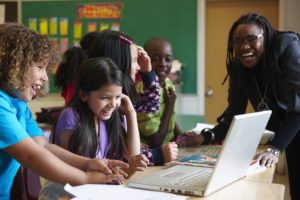 Over this past year, I have learned with central office leaders across the country. As with many leaders we hear from, one particular network of experienced central office leaders was feeling challenged by all of the important issues and decisions coming their way, including artificial intelligence, smartphones, social-emotional learning, contentious curriculum adoptions, and implementing new state policies, just to name a few. They shared that these larger challenges often distract from creating school environments where all students have the experiences they envision. More importantly, this group wanted to get back to their key role, being lead learners who impact student experiences and learning.
Over this past year, I have learned with central office leaders across the country. As with many leaders we hear from, one particular network of experienced central office leaders was feeling challenged by all of the important issues and decisions coming their way, including artificial intelligence, smartphones, social-emotional learning, contentious curriculum adoptions, and implementing new state policies, just to name a few. They shared that these larger challenges often distract from creating school environments where all students have the experiences they envision. More importantly, this group wanted to get back to their key role, being lead learners who impact student experiences and learning.
Through our work together, the network reflected upon the alignment between instructional practices and their vision for student experience and learning. Using our recently released Visioning Pyramid Explainer (VPE), they uncovered places where what students were experiencing in the classroom didn’t match their vision. Through our conversations, it became apparent that teaching and learning decisions made without the north star of a vision for student experience were negatively impacting students’ ability to thrive at school.
All of our work with leaders occurs in schools embedded in learning, teaching, and leading. During one of the network’s school visits last year, a superintendent poignantly shared his desire that all students are not only known well but also experience a true sense of belonging and inclusion throughout the school day. With the help of the Visioning Pyramid, this superintendent realized misalignments and asked his peers for help observing how student learning, teaching, and the school’s curricula were supporting or hindering student belonging and inclusion.
During our observations, we saw many moments where students were clearly experiencing belonging and inclusion. One was a math class on the playground, with students learning to approximate laughing and giggling as they measured their playful environment. Another was a reading lesson, with students analyzing text and then role-playing different characters. In both environments, the teachers paid close attention to student learning as well as the social context of the learning.
We also observed classrooms with the same curriculum where students were not engaged and, worse yet, working in isolation from each other. Sitting silently in rows, without access to their peers for support, students succeeded or struggled alone with the task at hand. The north star for this leader was for all students to have a sense of belonging and inclusion; during classroom observations guided by the VPE, we were able to see instructional practices and practice focuses that led directly to that outcome.
This leader and the network of leader learners quickly realized that while this school system had a strong vision for student experience, there was work to do for that vision to influence teacher professional learning. This led the team to consider how the vision should inform teacher professional learning.
While this school system offered a robust menu of teacher professional development opportunities, few were closely aligned with the district’s vision for student experience. Watching this superintendent and their team reflect on what was missing from their Vision Pyramid was quite remarkable. With support from others in the leaders’ network, they were quickly able to identify what vision-aligned teacher professional learning might look like. And reaffirmed for themselves that teacher professional learning is more than an obligation focused on implementation but rather a must-have component for living their vision as a school system.
As you move forward this year, let your vision for student experience and learning be the compass that guides your most important work: the day-to-day experience of students and the critical decisions you face in today’s challenging and ever-changing landscape.
